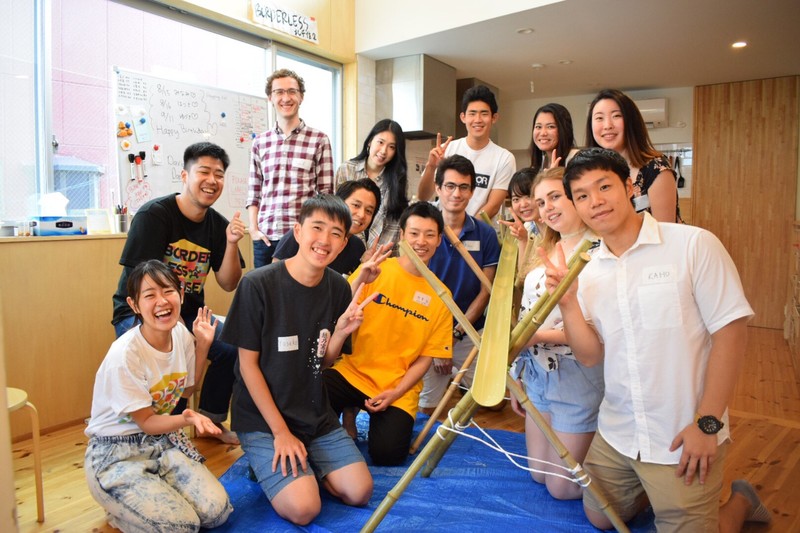Hi! I’m Yuya, in charge of our blog.
The Food Experience Program “BORDERLESS DINERS ~Experience International Restaurants and Travel around the World~”
It’s been half a year since we started this program! The theme for August was Japanese food to go back to the basics and know about the food culture in the place we live!
Have fun and get full with two of our staff from Shimane and Yamagata, the good old countryside, Takuya and Takky!
Let’s start BORERLESS DINERS!
Happy Half a Year Anniversary for the launch of the program! Satisfying Japanese cuisine that you makes you feel summer!

Japanese cuisine is very deep and has various types of dishes and ways too cook.
One of the best parts of Japanese cuisine is you can feel each of four seasons from it.
There are a lot of dishes which express the beauty of nature or a season and are closely related to the Japanese annual events.
“So the Japanese menu this time is from the dish with a plenty of summer vegetables to the food for the summer festival.
Let’s enjoy summer in Japan in terms of food!
Flow, Flow and be Flown! Kick-start with Flowing Somem.
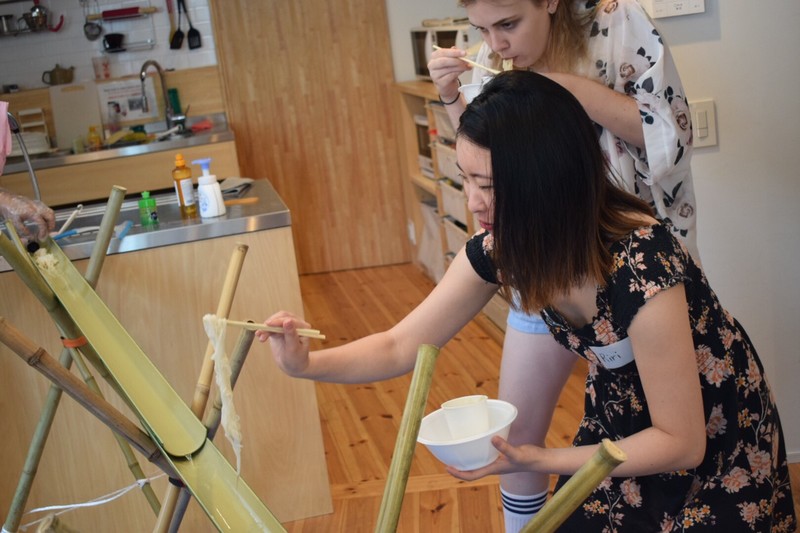
There is no summer without Somen!
When we dip the cold noodles cooled by ice in the cold soup and eat it, it feels like we get back the appetite that we lost because of heat.
Flowing Somen (Nagashi Somen in Japanese) is the summer tradition! In Flowing Somen,
Somen is flowing down a bamboo chute with ice-cold water and you catch and eat it!”
Someone just randomly thought “if we throw somen into flowing water, we will feel
summer very much, won’t we?”
As such, Flowing Somen was born in Kyushu and now it is the summer tradition.
So we kick-started with Flowing Somen to feel the absolute Japan.
First, we built the bamboo, then started throwing somen.
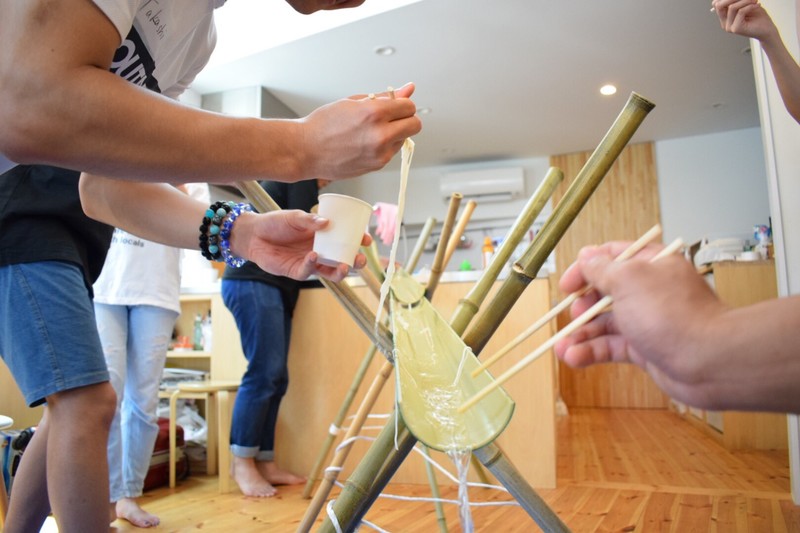
The flow was too fast to catch and eat Somen!
But gradually they were getting the tip and able to catch it!
One trouble of Flowing Somen is catching Somen is so much fun and eating it too much.
On the other hand, somen flowing in the bamboo chute looks so elegant and tasteful.

It was supposed to be a kick-start but we were already full.
Tried the traditional food “DASHI” (not the soy sauce dashi) of Yamagata!
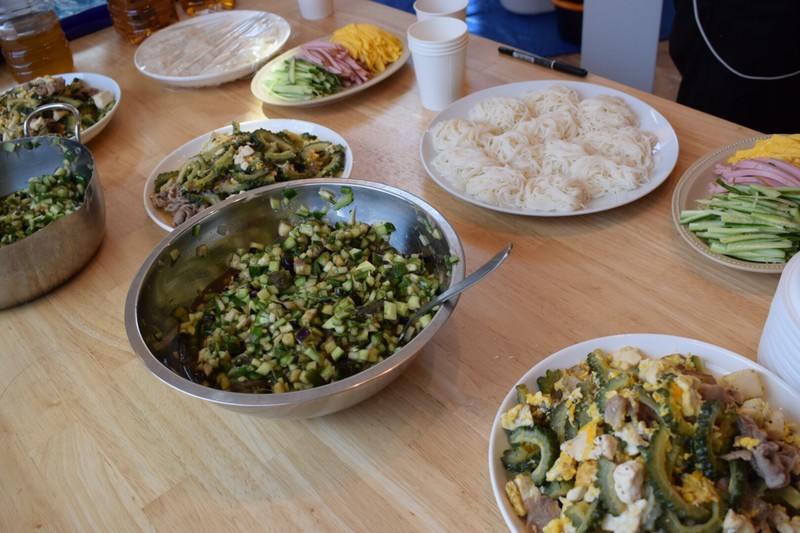
The next cuisine is “DASHI”.
It is not about the “Dashi” (Japanese soy sauce beased on fish) but about a traditional food of Yamagata eaten in the summer.
It is a mixture of cucumber, eggplant, and myoga (japanese ginger). It can be use in many way, like put on tofu, on somen etc…
It is also a high nutritional value food so, it is the perfect food when you lose your appetite in summer!
In Yamagata region, DASHI is a soul food which appear in the fridge every summer. And people feel the begining of summer by seing the DASHI.
“DASHI” is highly recommended by our staff Takky !

The french resident who have tried “DASHI” said: ” It is similar to the ratatouille of France!”
Ratatouille is a french cuisine which is a simmered dish of summer vegetables, and it is normally eaten itself but it is also tasteful to put on cheese and meat !
Don’t you think that it is quite interesting that french cuisine and the cuisine of Yamagata region have some similarities ??
Finding similarities between different culture is one of the enjoyable point of this program.
Cucumber and Miso soup is our friend (OR BEST PARTENER) of summer ! Let’s resolve summer weariness!
 The second cuisine is Cold miso soup.
The second cuisine is Cold miso soup.
It is a typical summer food eaten in different regions like Yamagata, Saitama, and Miyagi.
The recipy is : make some cold miso soup of cucumber and seasoning and put on hot rice. It is easy to make and easy to eat even you have lose appetite because of the high temperature of summer.
In the world, we can find some cold soup like vichyssoise or gazpacho. But in Japan it is not common to eat cold soup, and as we usually eat hot miso soup, for some Japanese, cold miso soup was a culture shock!
“Cold miso soup is delicious so we will made it in our house!” said our residents with their shiny smiles and they all have a refill of it.
Kaki-gori (shaved ice) the typical food of Matsuri (summer festival) was also eaten by Murasaki-shikibu (Japanese novelist) !?
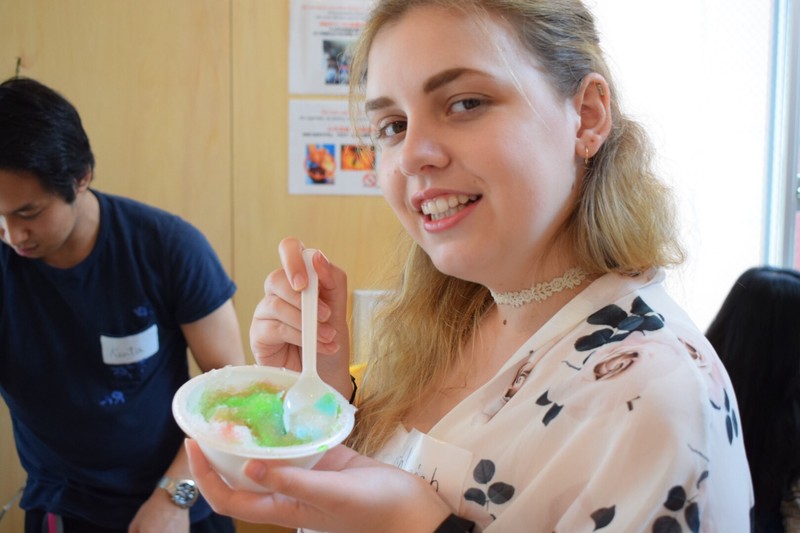
Kagi-gori is the perfect dessert for summer!
Kaki-gori is normally eaten in Natu-matsuri or Ennnichi ( japanese summer festival).
These days, Korean and Taiwanese kaki-gori is famous globally, we all have an image that kaki-gori is a modern food. However, the first time it was eaten was in Heian period (794~1185)!
In the famous book called “Makura-no-soushi”, they is a part that written about the shaved iced with honey. We can understand that kaki-gori is a traditional food with a long story.
It is loved globally even the taste and the form are changing by time.
It is emotional when we think deeply about it!
About the culture of “Washoku” (Japanese food) which is registrated on intangible cultural asset.
 Today’s theme “Washoku” is registated in the intangible cultural asset.
Today’s theme “Washoku” is registated in the intangible cultural asset.
The reason is because of it rareness. Indeed, it is globally not common to use diverse type of ingredients and we can also find a strong persistence to the food culture.
The Japanese cuisine change under season and event. We can understand how much Washoku have lived with culture.
Our resident was also very suprised of the fact that Washoku which is very familiar to us was registrated in the intangible cultural asset.
“Itadakimasu” (let’s eat) and “Gochisousama”(Thank you for the meal) are some gretting we can only find in Japan?
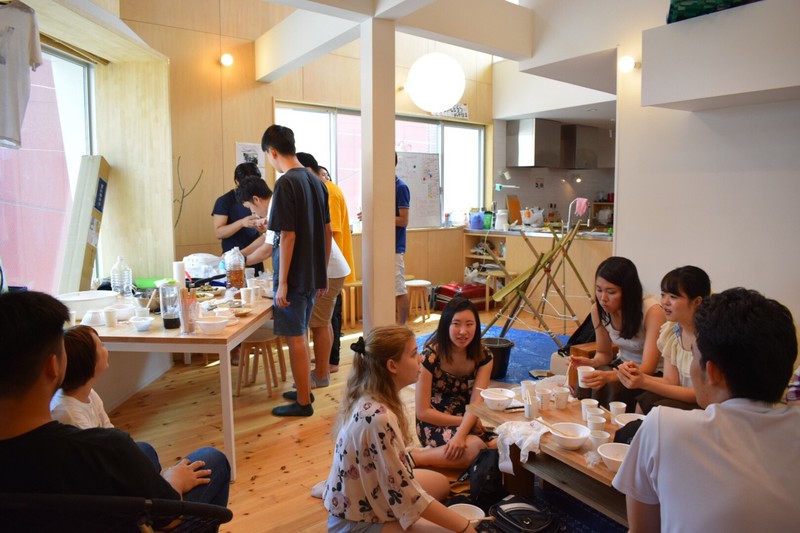
The another reason why Japanese food is included in intangible cultural asset is because of it rare greeting.
“Itadakimasu” and “Gochisousama” is a only Japanese gretting which we cannot translate in other language.
This greeting is based on Shinto religion which conciste to believe that god is everywhere. And it become ingrained in our culture to show our respect and gratitude to the ingredients, to the person who cooked the food and to the person who have procured the ingredients.
Thanks to this program, it was an opportunity to find that they are so much thing we don’t know about a culture even if we are living in.
Vietnam this week! The travelling restaurant which we can taste the world every month !
『BORDERLESS DINERS~Taste the world by the travelling restaurant ~』is a experience based program for the residents held every month !
The next country is Vietnam!
Two chefs who are wearing Ao dai ( Traditional Vietnamese costume) are going to cook some festival Vietnam cuisine!
Normally, Pho is a typical cuisine but you can try other food and taste deep Vietnamese culture!
What kind of experience can we do the next travelling ?
Looking forward to the next report !

